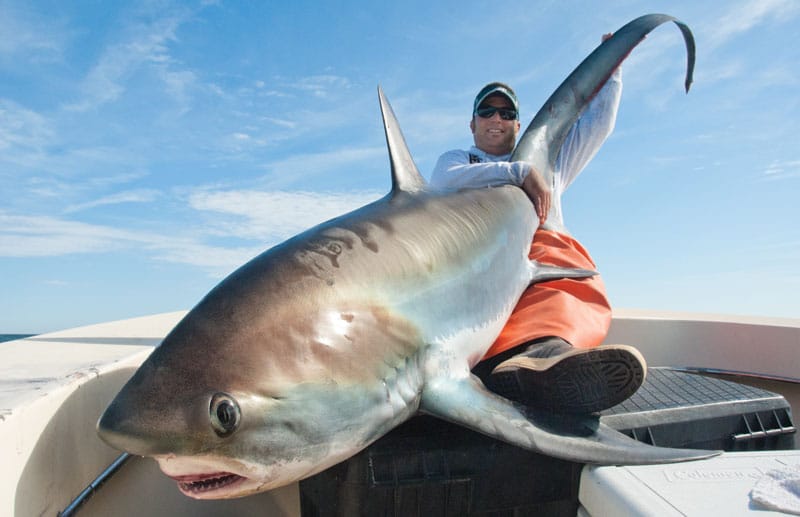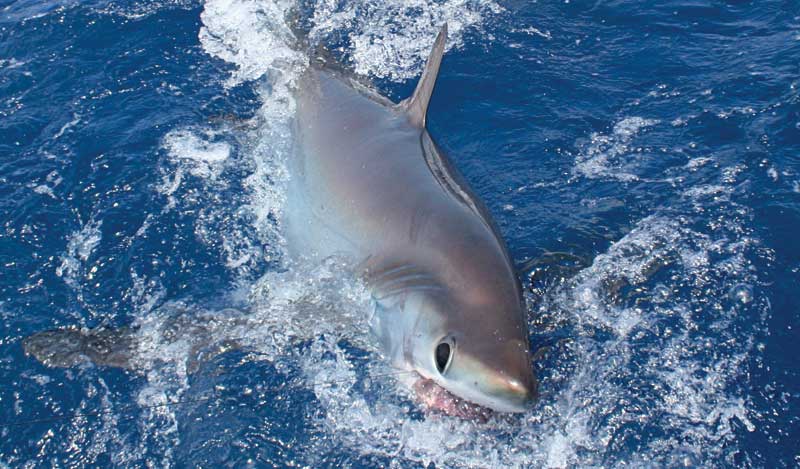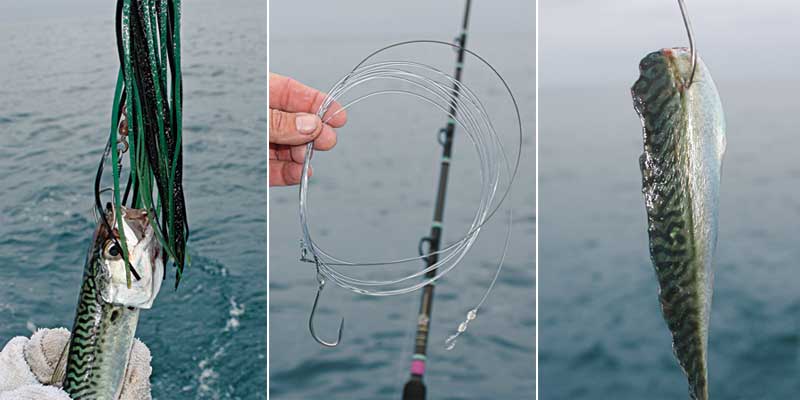
Thresher Shark Madness
The common thresher shark off Southern California is a miracle adaptation. Its compact, thickly-muscled body and elongated scythe-shape tail are perfectly designed for its unique method of feeding. Thresher sharks whip their tails — which can equal their overall body length — with pinpoint accuracy to stun sardines, anchovies, mackerel and other prey. Then they circle around to gulp down baitfish injured, killed or addled by the sudden concussion. When threshers feed in groups near the surface, you can often see and hear the commotion created by their fleshy bullwhips in action.
This unusual feeding style makes threshers challenging fish to catch — at least if you care about hooking them in the mouth. Because they attack baits and lures with their tail — often repeatedly — threshers are frequently foul-hooked by anglers, so much so that the technique of trolling rigged dead baits or swimming plugs for threshers has developed its own dubious nickname: the “drag-and-snag.”
Heads, You Win
It takes some effort to hook threshers in the mouth on a regular basis. It’s certainly worth it, for several reasons. Of course, there is the feeling of sportsmanship and fair play that comes with properly hooking and beating one of these majestic sharks on rod and reel. For tournament anglers and record seekers, there is the added benefit of keeping to IGFA rules. The best reason, however, is the undeniable fact that a mouth-hooked thresher shark puts up a much more fun and spirited fight.
“Threshers jump a lot and tend to stay on the surface when they’re hooked in the mouth,” says Dave Elm, production manager for AFTCO, chairman of United Anglers of Southern California and an avid thresher shark angler. Elm has held several Balboa Angling Club thresher shark records over the years, along with an IGFA world record on 16-pound line class. He and other Southern California thresher shark aficionados have refined bait-and-switch slow-trolling techniques that successfully attract trophy thresher sharks, minimize foul-hooking and get the sharks to inhale the bait — often right behind the boat. These techniques also increase the likelihood of a healthy release. The Balboa Angling Club has long worked to promote thresher shark conservation, offering release buttons and release points standings to recognize anglers who conserve these magnificent animals.
Where, When and What
Southern California anglers enjoy an excellent recreational fishery for thresher sharks, with bona fide big-game action close to home. When smaller 50- to 100-pound threshers gather to feed outside the kelp line, it’s even possible for kayak anglers to get in on the excitement.
Although primarily a spring and fall fishery, threshers can be caught anytime conditions are favorable. Elm looks for water of 59 to 63 degrees with a greenish-blue tinge that locals refer to as “dirty.” If there is a pronounced edge between green and blue water, he likes to fish the green side.
The other key factor in locating thresher sharks is the presence of bait. It could be schools of anchovies, sardines or mackerel — it doesn’t matter much as long as you’re metering good concentrations of forage. If you’re in the right color of water and marking suspended bait on the fish finder, you are where you want to be.
Although conditions change from day to day, some areas of the Orange County coast tend to be thresher feeding zones. Among these are the southern portions of Laguna Beach and the Newport Canyon area off the Newport Pier.
Elm focuses on two different depth zones and, in effect, two different fish populations. “Depending on where the bite has been happening, I fish along the 50-fathom curve or the 100-fathom curve farther offshore,” says Elm. Although it’s not written in stone, he usually finds sub-100-pound fish tighter to the beach. The bigger fish usually work deeper feeding zones, where you are more likely to encounter a typical 100- to 150-pound thresher — with a shot at the occasional 250-pound monster.
Handle with Care
You need to handle these fish carefully when you get them alongside the boat, paying particular attention to the rear end. Threshers don’t have the snaggletooth mouth and bad attitude that define makos, Southern California’s other popular game shark. What they do have is a five-foot tail that can slap you silly.
“To successfully and safely release a thresher, you want to keep the boat moving forward and the fish swimming as you bring him alongside,” says Elm. “When you have control of the leader, you want to either remove the hook with an ARC dehooker or cut the wire as close as possible to the fish’s mouth.”
Six Steps to Bait-and-Switch
“Threshers attack a bait with their tail, and as long as it keeps moving away from them, they’ll keep whacking at it,” says Elm. “So if you’re slow-trolling a rigged bait or diving plug, they will usually keep tail-slapping it until they get foul-hooked.” When they see the bait drop as if it is stunned, this often triggers them to turn and gulp it down. It’s as if the shark thinks to itself, “OK, my tail has done its job and killed that bait — now I can eat.”
Elm’s bait-and-switch techniques are designed to take advantage of this feeding behavior and instinctive reaction. Here’s how to employ them.
**1. ** Elm slow-trolls a teaser outfit designed to attract — but not hook — threshers with flash, action and the smell of real bait. He first rigs a large 16-ounce Bait-O-Matic with a whole fresh-dead mackerel. After experimenting with different ways of attaching the mackerel to the skirted head, Elm settled on a modified 6/0 snap swivel, passing the swivel clip through the eye sockets of the bait. To accomplish this, he bends the elongated clip of the swivel into a more circular shape. “I tried various ways of wiring or harnessing the bait but found it often couldn’t stand up to repeated tail strikes,” says Elm. “With the bait secured this way, the thresher can whack it repeatedly while I’m getting my hooked bait into position.”
2. Elm slow-trolls one rigged Bait-O-Matic at 112 to 3 knots. Unlike many anglers who troll Bait-O-Matics with hooks, Elm doesn’t use a downrigger, as it lacks the sensitivity to transmit the thresher’s tail strikes through the rod tip. At slower speeds, the larger 16-ounce Bait-O-Matic should get down to 30 feet.
**3. ** At the same time he’s trolling his Bait-O-Matic teaser, Elm runs one fly-lined skipbait about 50 to 75 feet behind the boat. This consists of a tail-on mackerel fillet rigged on a 4/0 hook so it flutters as it’s pulled through the water. He keeps this in the water because blind strikes can occur on the bait rather than the teaser. If Elm sees a tail or notices the skipbait getting whacked by a shark, he immediately pulls the throttles into neutral so the bait drops in the water column.
**4. ** Most times, the first indicators of a thresher shark in the vicinity are telltale raps on the teaser rod. When Elm sees this, he pulls the boat out of gear and has one angler retrieve the teaser at roughly trolling speed. This keeps the thresher interested in and attacking the teaser as it’s brought closer to the boat. A thresher will often whack the teaser right to the side of the boat, so try not to get buck fever.
**5. ** As this is going on, a second angler slowly retrieves the skipbait until it’s in sight about 30 feet behind the boat. This should be coordinated so the bait gets in position about the time you are ready to pull the teaser from the water. When the teaser comes out, the person working the other rod should give the skipbait a quick twitch and then let it fall naturally, with the reel in free-spool. If everything works right, the thresher will turn on the stunned mackerel fillet and chow down.
**6. ** Sometimes the shark will bite the bait a few times before really taking it. “Wait till he really rolls away with it, then put the reel in gear and set him up,” advises Elm.
**
California Thresher Sharks**
Rods: 5 1/2-foot stand-up tuna trolling rod for teaser outfit; 7-foot live-bait-action rod rated for 30- to 50-pound-test for skipbait.
Reels: Accurate ATD 30 for teaser outfit; Shimano TLD 15/20 or equivalent for bait outfit.
**Lines: ** 30- to 50-pound-test monofilament for bait outfit.
Lures: For teaser rig, 16-ounce Bait-O-Matic rigged without hooks to hold a whole dead mackerel.
Other: For the terminal rig, use 12 feet of 100-pound-test leader attached to the main line with a snap swivel, with 12 to 18 inches of single-strand wire, and a heavy-wire 4/0 live-bait hook. A mackerel fillet is used for bait.













